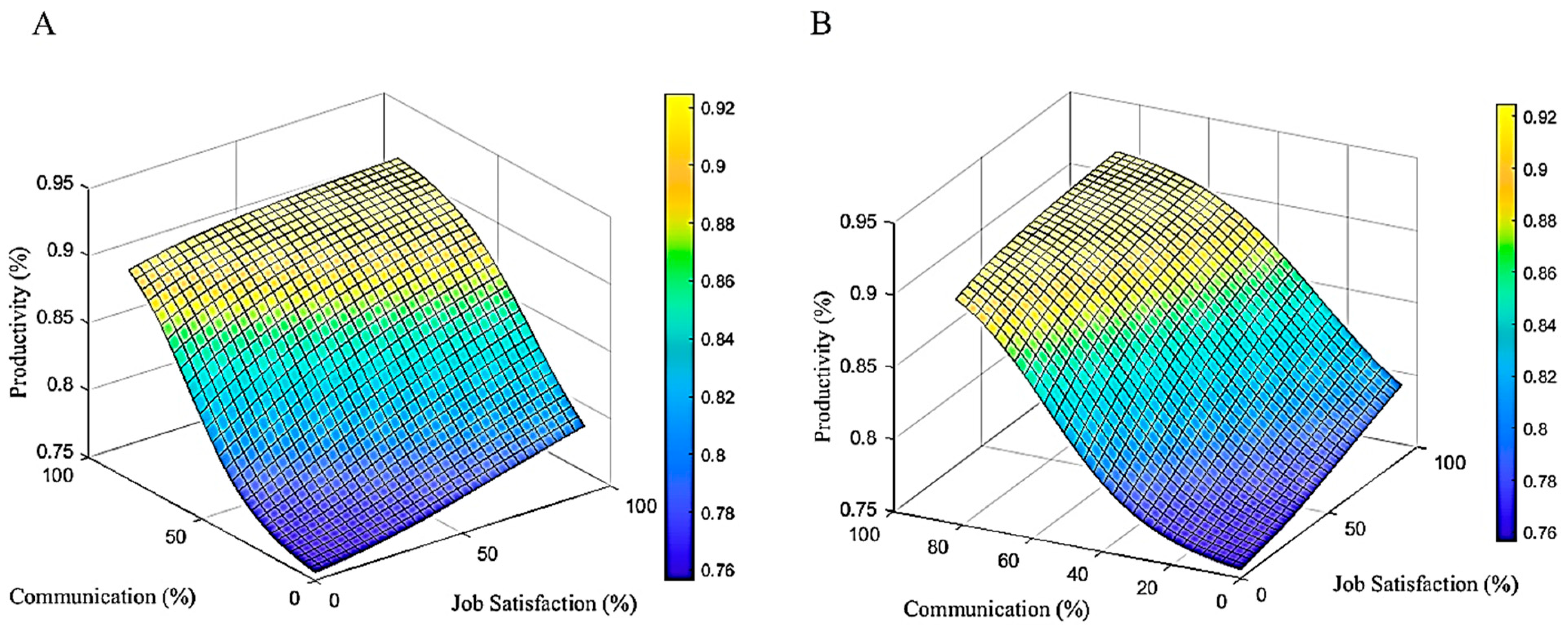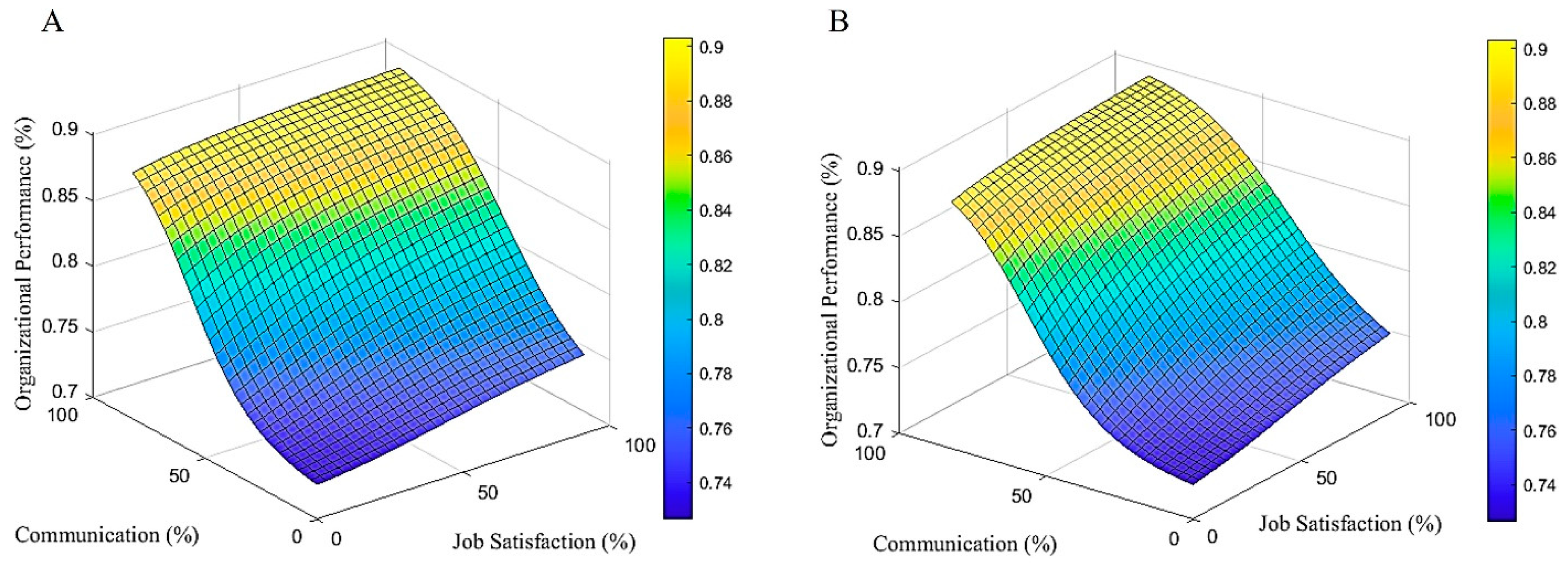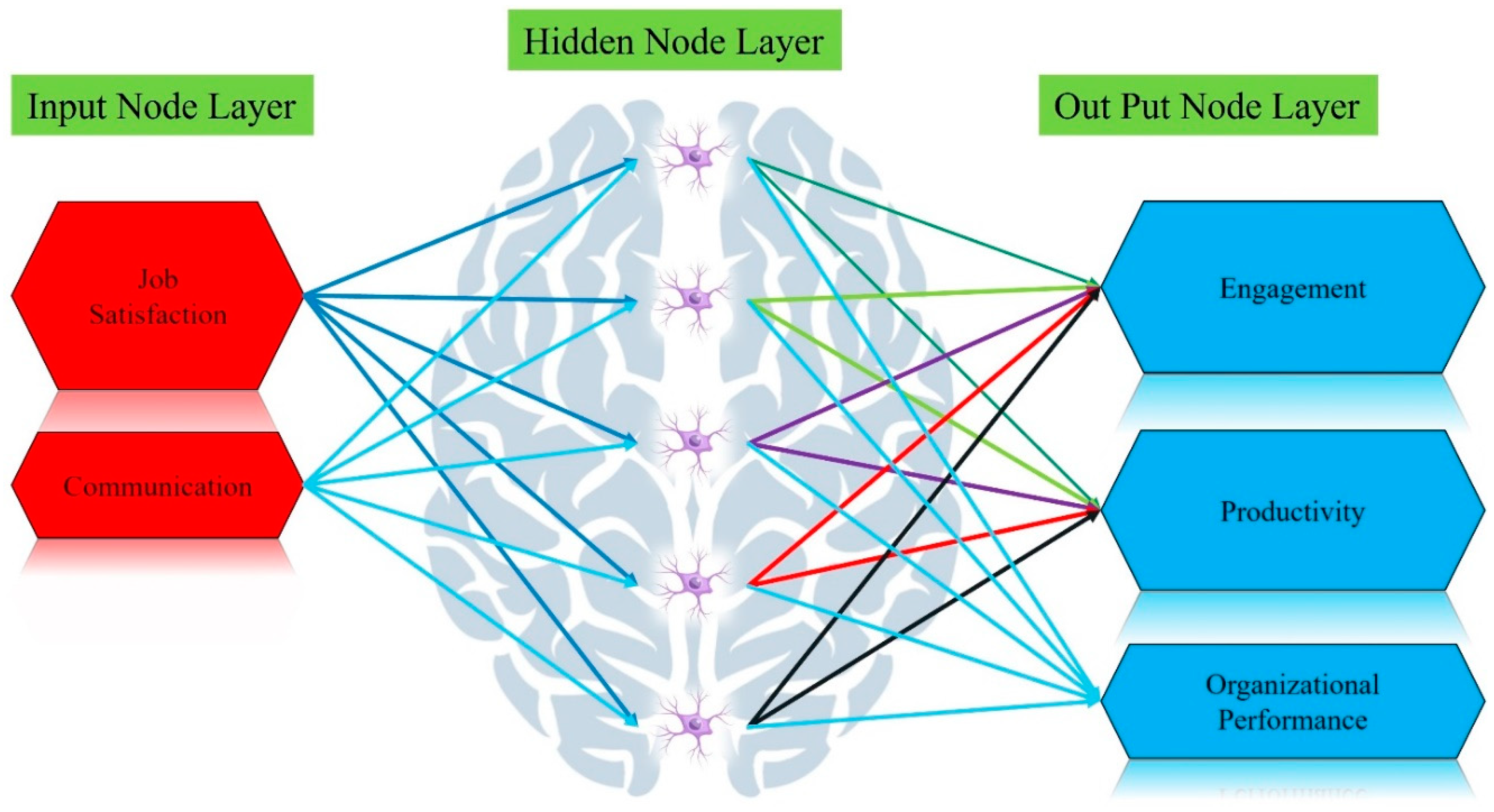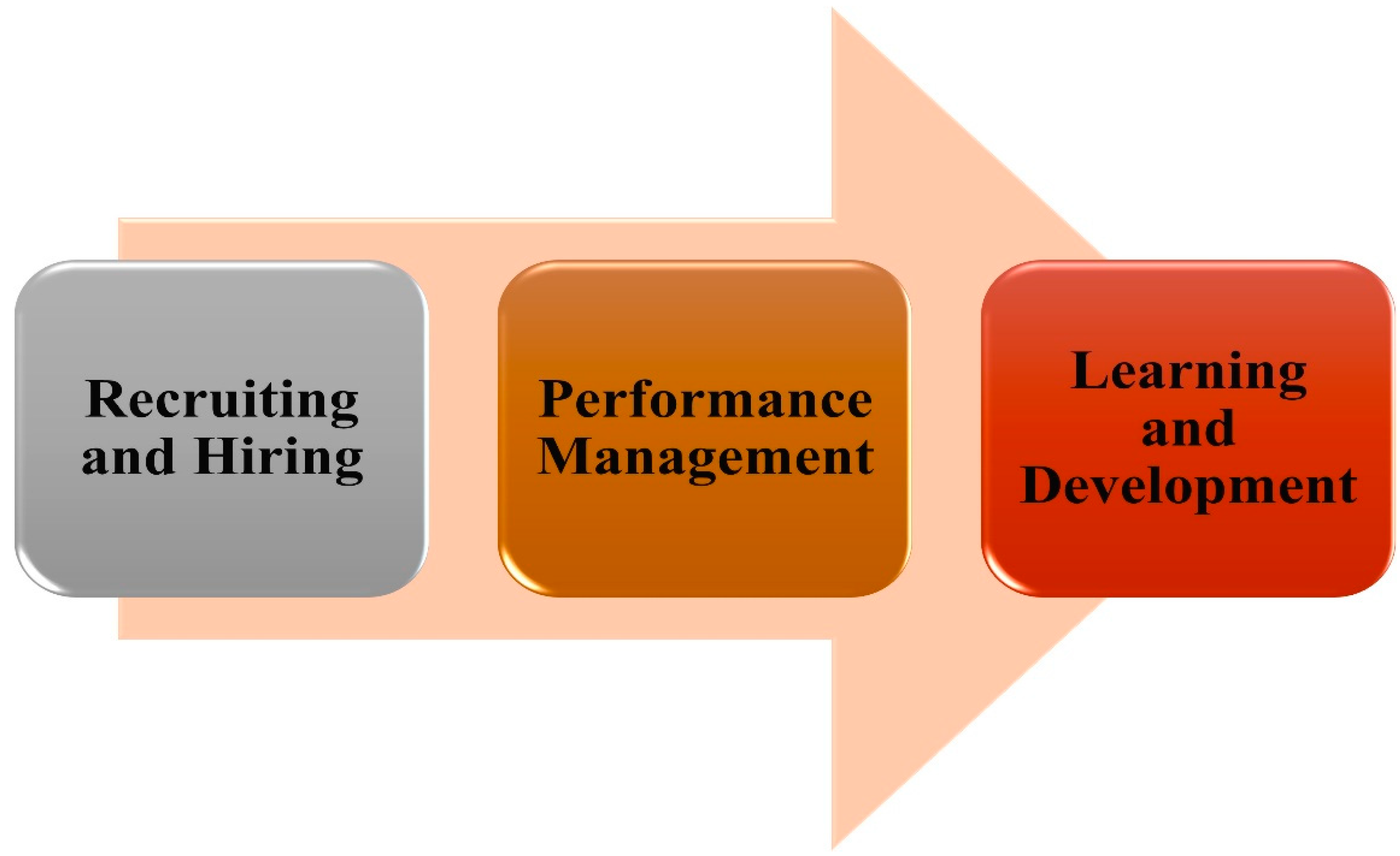Artificial Neural Networks (ANNs) and Machine Learning (ML) Modeling Employee Behavior with Management Towards the Economic Advancement of Workers
Abstract
1. Introduction
2. Research Methodology
3. Results and Discussion
4. Conclusions
Funding
Institutional Review Board Statement
Informed Consent Statement
Data Availability Statement
Conflicts of Interest
References
- Garg, S.; Sinha, S.; Kar, A.K.; Mani, M. A review of machine learning applications in human resource management. Int. J. Product. Perform. Manag. 2022, 71, 1590–1610. [Google Scholar] [CrossRef]
- Zhu, H. Research on human resource recommendation algorithm based on machine learning. Sci. Program. 2021, 2021, 8387277. [Google Scholar] [CrossRef]
- Pap, J.; Mako, C.; Illessy, M.; Kis, N.; Mosavi, A. Modeling organizational performance with machine learning. J. Open Innov. Technol. Mark. Complex. 2022, 8, 177. [Google Scholar] [CrossRef]
- Pekel Ozmen, E.; Ozcan, T. A novel deep learning model based on convolutional neural networks for employee churn prediction. J. Forecast. 2022, 41, 539–550. [Google Scholar] [CrossRef]
- Riaz, H.; Ghanghas, S. Artificial Intelligence in Employee Performance Evaluation and Its Managerial Implication. J. Inform. Educ. Res. 2024, 4, 299–307. [Google Scholar]
- Bankins, S.; Ocampo, A.C.; Marrone, M.; Restubog, S.L.D.; Woo, S.E. A multilevel review of artificial intelligence in organizations: Implications for organizational behavior research and practice. J. Organ. Behav. 2024, 45, 159–182. [Google Scholar] [CrossRef]
- Indira, G.; Bhavani, M.; Brinda, R.; Zahira, R. Electricity Load Demand Prediction for Microgrid Energy Management System Using Hybrid Adaptive Barnacle-Mating Optimizer with Artificial Neural Network Algorithm. Energy Technol. 2024, 12, 2301091. [Google Scholar] [CrossRef]
- Thomas, B.; Senith, S.; Kirubaraj, A.A.; Ramson, S.J. Does management graduates’ emotional intelligence competencies predict their work performance? Insights from Artificial Neural Network Study. Mater. Today Proc. 2022, 58, 466–472. [Google Scholar] [CrossRef]
- Gong, Y.; Zhao, M.; Wang, Q.; Lv, Z. Design and interactive performance of human resource management system based on artificial intelligence. PLoS ONE 2022, 17, e0262398. [Google Scholar] [CrossRef] [PubMed]
- Pereira, V.; Hadjielias, E.; Christofi, M.; Vrontis, D. A systematic literature review on the impact of artificial intelligence on workplace outcomes: A multi-process perspective. Hum. Resour. Manag. Rev. 2023, 33, 100857. [Google Scholar] [CrossRef]
- Arzani, S.; Fatalla, A.; Veseli, E.; Khademi, A.; Khandan, A.; Fahmy, M.; Mirmohammadi, H.; Hasselgren, G.; Bang, H.; Kolahi, J.; et al. Revolutionizing systematic reviews and meta-analyses: The role of artificial intelligence in evidence synthesis. Dent. Hypotheses 2023, 14, 93–94. [Google Scholar] [CrossRef]
- Nath, G.; Wang, Y.; Coursey, A.; Saha, K.K.; Prabhu, S.; Sengupta, S. Incorporating a machine learning model into a Web-based administrative decision support tool for predicting workplace absenteeism. Information 2022, 13, 320. [Google Scholar] [CrossRef]
- Borch, C.; Hee Min, B. Toward a sociology of machine learning explainability: Human–machine interaction in deep neural network-based automated trading. Big Data Soc. 2022, 9, 20539517221111361. [Google Scholar] [CrossRef]
- Biswas, A.K.; Seethalakshmi, R.; Mariappan, P.; Bhattacharjee, D. An ensemble learning model for predicting the intention to quit among employees using classification algorithms. Decis. Anal. J. 2023, 9, 100335. [Google Scholar] [CrossRef]
- Benbya, H.; Davenport, T.H.; Pachidi, S. Artificial intelligence in organizations: Current state and future opportunities. MIS Q. Exec. 2020, 19, 4. [Google Scholar] [CrossRef]
- Mukhamediev, R.I.; Popova, Y.; Kuchin, Y.; Zaitseva, E.; Kalimoldayev, A.; Symagulov, A.; Levashenko, V.; Abdoldina, F.; Gopejenko, V.; Yakunin, K.; et al. Review of artificial intelligence and machine learning technologies: Classification, restrictions, opportunities and challenges. Mathematics 2022, 10, 2552. [Google Scholar] [CrossRef]
- Gue, I.H.V.; Ubando, A.T.; Tseng, M.L.; Tan, R.R. Artificial neural networks for sustainable development: A critical review. Clean Technol. Environ. Policy 2020, 22, 1449–1465. [Google Scholar] [CrossRef]
- Mer, A.; Srivastava, A. Employee engagement in the new normal: Artificial intelligence as a buzzword or a game changer? In The Adoption and Effect of Artificial Intelligence on Human Resources Management, Part A; Emerald Publishing Limited.: Bingley, UK, 2023; pp. 15–46. [Google Scholar]
- Ranta, M.; Ylinen, M. Employee benefits and company performance: Evidence from a high-dimensional machine learning model. Manag. Account. Res. 2023, 2023, 100876. [Google Scholar] [CrossRef]
- Mittal, S.; Mahendra, S.; Sanap, V.; Churi, P. How can machine learning be used in stress management: A systematic literature review of applications in workplaces and education. Int. J. Inf. Manag. Data Insights 2022, 2, 100110. [Google Scholar] [CrossRef]
- Kamatchi, D.; Kumar, B.V. Application of Artificial Neural Network with Various Algorithms Tools in Numerous Sectors—A Review. Period. Mineral. 2022, 91. [Google Scholar]
- Ozden, E.; Guleryuz, D. Optimized machine learning algorithms for investigating the relationship between economic development and human capital. Comput. Econ. 2022, 60, 347–373. [Google Scholar] [CrossRef]
- Chan, J.Y.; Wang, Z.; Xie, Y.; Meisel, C.A.; Meisel, J.D.; Solano, P.; Murillo, H. Identifying potential managerial personnel using pagerank and social network analysis: The case study of a european it company. Appl. Sci. 2021, 11, 6985. [Google Scholar] [CrossRef]
- Kumar, M.; Raut, R.D.; Mangla, S.K.; Ferraris, A.; Choubey, V.K. The adoption of artificial intelligence powered workforce management for effective revenue growth of micro, small, and medium scale enterprises (MSMEs). Prod. Plan. Control 2022, 1–17. [Google Scholar] [CrossRef]
- Zohuri, B.; Rahmani, F.M. Artificial intelligence driven resiliency with machine learning and deep learning components. Jpn. J. Res. 2023, 1, 1–5. [Google Scholar] [CrossRef]
- Gao, Q.; Xu, J.; Wang, Q.; Wu, C. The use of the analytic hierarchy process in improving psychological empowerment and employee performance. J. Organ. End User Comput. (JOEUC) 2023, 35, 1–22. [Google Scholar] [CrossRef]
- Kaushal, N.; Kaurav, R.P.S.; Sivathanu, B.; Kaushik, N. Artificial intelligence and HRM: Identifying future research Agenda using systematic literature review and bibliometric analysis. Manag. Rev. Q. 2023, 73, 455–493. [Google Scholar] [CrossRef]
- Anshari, M.; Syafrudin, M.; Tan, A.; Fitriyani, N.L.; Alas, Y. Optimisation of knowledge management (KM) with machine learning (ML) Enabled. Information 2023, 14, 35. [Google Scholar] [CrossRef]
- Young, A.G.; Majchrzak, A.; Kane, G.C. Organizing workers and machine learning tools for a less oppressive workplace. Int. J. Inf. Manag. 2021, 59, 102353. [Google Scholar] [CrossRef]
- Sturm, T.; Gerlach, J.P.; Pumplun, L.; Mesbah, N.; Peters, F.; Tauchert, C.; Nan, N.; Buxmann, P. Coordinating Human and Machine Learning for Effective Organizational Learning. MIS Q. 2021, 45, 1581–1602. [Google Scholar] [CrossRef]
- Momade, M.H.; Durdyev, S.; Dixit, S.; Shahid, S.; Alkali, A.K. Modeling labor costs using artificial intelligence tools. Int. J. Build. Pathol. Adapt. 2022. [Google Scholar] [CrossRef]
- Baashar, Y.; Alkawsi, G.; Mustafa, A.; Alkahtani, A.A.; Alsariera, Y.A.; Ali, A.Q.; Hashim, W.; Tiong, S.K. Toward predicting student’s academic performance using artificial neural networks (ANNs). Appl. Sci. 2022, 12, 1289. [Google Scholar] [CrossRef]
- Noman, A.A.; Akter, U.H.; Pranto, T.H.; Haque, A.K.M. Machine learning and artificial intelligence in circular economy: A bibliometric analysis and systematic literature review. Ann. Emerg. Technol. Comput. (AETiC) 2022, 6, 13–40. [Google Scholar] [CrossRef]
- Florez-Perez, L.; Song, Z.; Cortissoz, J.C. Using machine learning to analyze and predict construction task productivity. Comput. -Aided Civ. Infrastruct. Eng. 2022, 37, 1602–1616. [Google Scholar] [CrossRef]
- Farashaei, D.; Honarbakhsh, A.; Movahedifar, S.M.; Shakeri, E. Individual flexibility and workplace conflict: Cloud-based data collection and fusion of neural networks. Wirel. Netw. 2022, 30, 4093–4108. [Google Scholar] [CrossRef]
- Uppal, M.; Gupta, D.; Juneja, S.; Dhiman, G.; Kautish, S. Cloud-based fault prediction using IoT in office automation for improvisation of health of employees. J. Healthc. Eng. 2021, 2021, 8106467. [Google Scholar] [CrossRef]
- Lee, A.; Inceoglu, I.; Hauser, O.; Greene, M. Determining causal relationships in leadership research using Machine Learning: The powerful synergy of experiments and data science. Leadersh. Q. 2022, 33, 101426. [Google Scholar] [CrossRef]
- Baduge, S.K.; Thilakarathna, S.; Perera, J.S.; Arashpour, M.; Sharafi, P.; Teodosio, B.; Shringi, A.; Mendis, P. Artificial intelligence and smart vision for building and construction 4.0: Machine and deep learning methods and applications. Autom. Constr. 2022, 141, 104440. [Google Scholar] [CrossRef]
- Vatansever, S.; Schlessinger, A.; Wacker, D.; Kaniskan, H.Ü.; Jin, J.; Zhou, M.M.; Zhang, B. Artificial intelligence and machine learning-aided drug discovery in central nervous system diseases: State-of-the-arts and future directions. Med. Res. Rev. 2021, 41, 1427–1473. [Google Scholar] [CrossRef] [PubMed]
- Tariq, M.U.; Poulin, M.; Abonamah, A.A. Achieving operational excellence through artificial intelligence: Driving forces and barriers. Front. Psychol. 2021, 12, 686624. [Google Scholar] [CrossRef]
- Zhang, S.; Zhang, C.; Su, Z.; Zhu, M.; Ren, H. New structural economic growth model and labor income share. J. Bus. Res. 2023, 160, 113644. [Google Scholar] [CrossRef]
- Zhang, S.; Li, X.; Zhang, C.; Luo, J.; Cheng, C.; Ge, W. Measurement of factor mismatch in industrial enterprises with labor skills heterogeneity. J. Bus. Res. 2023, 158, 113643. [Google Scholar] [CrossRef]
- Li, J.; Liao, Y.; Wang, W.; Han, X.; Cheng, Z.; Sun, G. Is stress always bad? the role of job stress in producing innovative ideas. Knowl. Manag. Res. Pract. 2023, 21, 1–12. [Google Scholar] [CrossRef]
- Duan, W.; Madasi, J.D.; Khurshid, A.; Ma, D. Industrial structure conditions economic resilience. Technol. Forecast. Soc. Chang. 2022, 183, 121944. [Google Scholar] [CrossRef]
- Duan, W.; Li, C. Be alert to dangers: Collapse and avoidance strategies of platform ecosystems. J. Bus. Res. 2023, 162, 113869. [Google Scholar] [CrossRef]
- Li, G.; Luo, J.; Liu, S. Performance Evaluation of Economic Relocation Effect for Environmental Non-Governmental Organizations: Evidence from China. Economics 2024, 18, 20220080. [Google Scholar] [CrossRef]
- Liu, B.; Li, M.; Ji, Z.; Li, H.; Luo, J. Intelligent Productivity Transformation: Corporate Market Demand Forecasting With the Aid of an AI Virtual Assistant. J. Organ. End User Comput. (JOEUC) 2024, 36, 1–27. [Google Scholar] [CrossRef]
- Zhu, D.; Bahadur, W.; Ali, M. The effect of spiritual leadership on proactive customer service performance: The roles of psychological empowerment and power distance. Humanit. Soc. Sci. Commun. 2023, 10, 792. [Google Scholar] [CrossRef]
- Zhang, H.M.; Liu, J.Y.; Chen, J.W. The double-edged sword effect of performance pressure on employee boundary-spanning behavior. J. Chin. Hum. Resour. Manag. 2024, 15, 86–103. [Google Scholar]
- Mushtaq, N.; Xing, M.J.; Bakhtawar, A.; Mufti, M.A. Elevating the influence of HR analytics on organizational performance: An empirical investigation in Hi-Tech manufacturing industry of a developing economy. J. Chin. Hum. Resour. Manag. 2024, 15, 3–40. [Google Scholar]
- Zhu, C. An Adaptive Agent Decision Model Based on Deep Reinforcement Learning and Autonomous Learning. J. Logist. Inform. Serv. Sci. 2023, 10, 107–118. [Google Scholar]
- Lv, X.L.; Chiang, H.D. Visual clustering network-based intelligent power lines inspection system. Eng. Appl. Artif. Intell. 2024, 129, 107572. [Google Scholar] [CrossRef]
- Li, T.; Wang, Z. The bifurcation of constrained optimization optimal solutions and its applications. AIMS Math. 2023, 8, 12373–12397. [Google Scholar] [CrossRef]
- Li, S.; Fang, X.; Liao, J.; Ghadamyari, M.; Khayatnezhad, M.; Ghadimi, N. Evaluating the efficiency of CCHP systems in Xinjiang Uygur Autonomous Region: An optimal strategy based on improved mother optimization algorithm. Case Stud. Therm. Eng. 2024, 54, 104005. [Google Scholar] [CrossRef]
- Khan, M.A.; Abbas, K.; Su’ud, M.M.; Salameh, A.A.; Alam, M.M.; Aman, N.; Mehreen, M.; Jan, A.; Hashim, N.A.A.B.N.; Aziz, R.C. Application of machine learning algorithms for sustainable business management based on macro-economic data: Supervised learning techniques approach. Sustainability 2022, 14, 9964. [Google Scholar] [CrossRef]









| Case | Input Factors | Output Factors | |||
|---|---|---|---|---|---|
| Job Satisfaction | Communication | Engagement | Productivity | Organizational Performance | |
| 1 | 82% | 71% | 78% | 83% | 79% |
| 2 | 68% | 65% | 72% | 75% | 72% |
| 3 | 89% | 78% | 86% | 91% | 88% |
| 4 | 75% | 68% | 74% | 79% | 76% |
| 5 | 91% | 82% | 90% | 93% | 91% |
| Factor | Description |
|---|---|
| Employee Engagement | The degree to which employees are motivated, committed, and willing to contribute to the organization’s success. High engagement is linked to greater productivity and economic gains. |
| Employee Voice and Participation | Opportunities for workers to provide feedback, share ideas, and participate in decision-making. Enhances employee empowerment and alignment of interests. |
| Workplace Policies and Benefits | The generosity and progressiveness of an organization’s offerings around work–life balance, healthcare, retirement, etc. Supports long-term economic security for employees. |
| Labor–Management Cooperation | The level of trust, open communication, and willingness to collaborate between employees/unions and management. Enables “win–win” outcomes. |
| Equity and Inclusion | Addressing disparities in pay, opportunities, and treatment based on factors like gender, race, and age. Crucial for broad-based economic progress. |
| Outcome | Description |
|---|---|
| Increased Productivity | Engaged, empowered employees contribute more to the organization’s economic output. |
| Improved Workforce Retention | Workers are more likely to remain with an employer that supports their economic wellbeing. |
| Stronger Financial Security | Generous benefits, equitable pay, and wealth-building opportunities lead to greater economic security for employees. |
| Higher Employee Satisfaction | When workers feel valued and have a voice, job satisfaction and morale tend to be higher. |
| Organizational Profitability | Cooperative, productive labor–management dynamics ultimately benefit the company’s bottom line. |
| Broader Economic Prosperity | Widespread employee economic progress supports the broader societal goals of economic equity and mobility. |
| Best Practice Area | Specific Initiatives |
|---|---|
| Recruitment and Hiring | - Analyze job descriptions and hiring criteria for biases - Diversify candidate sourcing methods - Implement structured, skills-based interviews - Set diversity hiring goals and hold managers accountable |
| Compensation and Advancement | - Conduct regular pay equity audits - Implement transparent, equitable compensation structures - Provide training and development opportunities - Monitor and address disparities in performance reviews and promotions |
| Inclusive Culture | - Foster an environment where all employees feel respected and valued - Provide diversity and inclusion training - Encourage employee resource groups - Solicit feedback from diverse employees |
| Accountability and Transparency | - Set clear DE&I goals with metrics and timelines - Regularly report on progress and make data public - Tie manager/executive compensation to DE&I outcomes - Establish reporting channels and non-retaliation policies |
Disclaimer/Publisher’s Note: The statements, opinions and data contained in all publications are solely those of the individual author(s) and contributor(s) and not of MDPI and/or the editor(s). MDPI and/or the editor(s) disclaim responsibility for any injury to people or property resulting from any ideas, methods, instructions or products referred to in the content. |
© 2024 by the author. Licensee MDPI, Basel, Switzerland. This article is an open access article distributed under the terms and conditions of the Creative Commons Attribution (CC BY) license (https://creativecommons.org/licenses/by/4.0/).
Share and Cite
Lee, C. Artificial Neural Networks (ANNs) and Machine Learning (ML) Modeling Employee Behavior with Management Towards the Economic Advancement of Workers. Sustainability 2024, 16, 9516. https://doi.org/10.3390/su16219516
Lee C. Artificial Neural Networks (ANNs) and Machine Learning (ML) Modeling Employee Behavior with Management Towards the Economic Advancement of Workers. Sustainability. 2024; 16(21):9516. https://doi.org/10.3390/su16219516
Chicago/Turabian StyleLee, Cristina. 2024. "Artificial Neural Networks (ANNs) and Machine Learning (ML) Modeling Employee Behavior with Management Towards the Economic Advancement of Workers" Sustainability 16, no. 21: 9516. https://doi.org/10.3390/su16219516
APA StyleLee, C. (2024). Artificial Neural Networks (ANNs) and Machine Learning (ML) Modeling Employee Behavior with Management Towards the Economic Advancement of Workers. Sustainability, 16(21), 9516. https://doi.org/10.3390/su16219516





